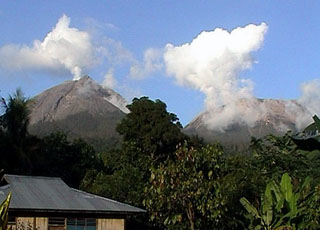Report on Lewotobi (Indonesia) — 26 March-1 April 2025
Smithsonian Institution / US Geological Survey
Weekly Volcanic Activity Report, 26 March-1 April 2025
Managing Editor: Sally Sennert.
Please cite this report as:
Global Volcanism Program, 2025. Report on Lewotobi (Indonesia) (Sennert, S, ed.). Weekly Volcanic Activity Report, 26 March-1 April 2025. Smithsonian Institution and US Geological Survey.
Lewotobi
Indonesia
8.542°S, 122.775°E; summit elev. 1703 m
All times are local (unless otherwise noted)
The Pusat Vulkanologi dan Mitigasi Bencana Geologi (PVMBG) reported that activity at Lewotobi Laki-laki significantly decreased after the more intense eruptive phase during 20-21 March, though ash plumes continued to be periodically observed. Minor incandescent at the summit was occasionally visible during 22-27 March, though absent during 28-30 March. Seismicity decreased overall; the number of earthquakes indicating emissions notably deceased, both low-frequency and volcanic earthquakes decreased, harmonic tremor fluctuated though was stable, and shallow volcanic earthquakes were not detected. The report warned that deposits of material especially on the WNW and NNE flanks increased the potential for lahars. During 25-26 March white plumes rose 100-500 m above the summit and drifted N and NE. On 26 March the exclusion zone was decreased to a radius of 6 km from the center of Laki-laki and 7 km in a semicircle clockwise from the SW to the NE. On 27 March white-and-gray plumes rose 100-300 m above the summit and drifted N and NE. During 28-30 March and 1 April white plumes rose 100-500 m above the summit and drifted in multiple directions. At 1200 on 30 March the Alert Level was lowered to 3 (on a scale of 1-4) and the public was warned to stay 6 km away from the center of Laki-laki. A white and gray plume rose 500 m above the summit on 31 March and drifted N and NE.
Geological Summary. The Lewotobi edifice in eastern Flores Island is composed of the two adjacent Lewotobi Laki-laki and Lewotobi Perempuan stratovolcanoes (the "husband and wife"). Their summits are less than 2 km apart along a NW-SE line. The conical Laki-laki to the NW has been frequently active during the 19th and 20th centuries, while the taller and broader Perempuan has had observed eruptions in 1921 and 1935. Small lava domes have grown during the 20th century in both of the summit craters, which are open to the north. A prominent cone, Iliwokar, occurs on the E flank of Perampuan.
Source: Pusat Vulkanologi dan Mitigasi Bencana Geologi (PVMBG, also known as CVGHM)

